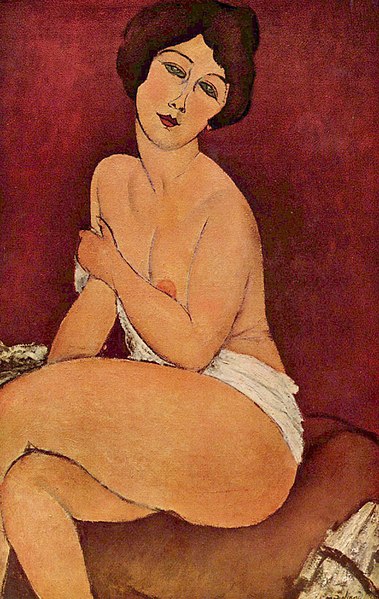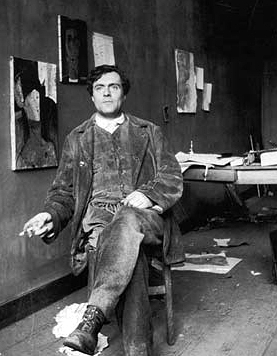Jacob MILKIN
January 3, 2019Simon MONDZAIN
January 3, 2019Amedeo MODIGLIANI
LIVORNO (ITALY) 1884 – PARIS 1920
Amedeo Modigliani was born on July 12, 1884 in Livorno, Italy. He was the fourth and youngest child in a family of Sephardic Jews. In 1884, the family business dealing in wood and coal from mines in Sardinia went bankrupt. In 1886, his mother Eugénie Garsin, who was originally from France, gave private classes. Together with her sister Laura, they turned the house into a school. Emmanuele, the eldest child, became a lawyer and a socialist member of parliament. Marguerita, the only daughter among the four children, remained single and became the adoptive mother of Jeanne, the daughter of Amedeo and Jeanne Hébuterne. As for Umberto, he became a civil engineer.
In 1898, Modigliani enrolled in the School of Fine Arts in Livorno. He took Guglielmo Micheli’s classes. In September 1900, he contracted pleurisy, which developed into tuberculosis. He spent the summer of 1902 in Rome where he copied paintings in museums. In Florence, he enrolled in the free school of the nude, took Giovanni Fattori’s classes, and met Manuel Ortiz de Zarate, an artist from Chile who told him about Paris.
From 1903 to 1906, he continued studying at the free school of the nude in the School of Fine Arts in Venice. Thanks to some money that his mother gave him, Modigliani arrived in Paris in January 1906. He first lived in a hotel for a few days, and later settled in rue Caulaincourt near the Bateau-Lavoir in Montmartre. There, he met Picasso, Derain, Apollinaire, Diego Rivera, Max Jacob, and Jacques Lipchitz. He enrolled in the Académie Colarossi. That same year, he exhibited three paintings at Laura Wylda’s gallery in rue des Saints-Peres. In 1907, he moved apartments several times and met Maurice Utrillo and André Utter. He started to spend time in cabarets in Montmartre, and began drinking and smoking hashish. In November, he met Dr Paul Alexandre, who supported him until 1914 by regularly purchasing his canvases.
In 1908, Modigliani exhibited six paintings at the Salon des Indépendants, including The Jewess, which was bought by Paul Alexandre. In Montmartre, he sculpted heads out of crossties he found at Barbes-Rochechouart métro station. Following the general trend, in September 1909, he left Montmartre for Montparnasse and settled at number 14 Cité Falguiere. He took an interest in sculpture and carved rock with Constantin Brancusi. At that time, he met Zadkine, Kisling, and Foujita. In 1913, he resumed painting. In 1914, Modigliani and Ortiz de Zarate wanted to join the army. However, they could not enlist because of health reasons. Modigliani met Beatrice Hastings, an English journalist and poetess. In 1915, Max Jacob introduced him to the art dealer and collector Paul Guillaume. Modigliani produced about one painting every six days and painted numerous portraits. He spent a lot of time with Beatrice Hastings at the café La Rotonde and at Marie Vassilieff’s canteen. He met Soutine who he considered a brilliant painter. The two artists became very close friends. During the summer 1916, Léopold Zborowski became his dealer. In 1917, Modigliani worked at Zborowski’s at 3 rue Joseph-Bara. He gave him his production in exchange for fifteen to twenty francs per day. That winter, he produced his first series of nudes. In March 1917, he met nineteen-year-old Jeanne Hébuterne who was a student at the Académie Colarossi Academy. She became his companion and moved in with him into the small studio found for them by Zborowski at 8 rue de la Grande-Chaumiere.
On December 3, 1917, Zborowski organized Modigliani’s first solo exhibition at the Galerie Berthe Weill. Blaise Cendrars wrote a poem for the catalogue’s preface. Modigliani’s health got worse and the couple settled in Cagnes-sur-Mer, where Soutine, Foujita, Léopold Survage, Anders Osterlind, Blaise Cendrars, and Paul Guillaume were also staying. Jeanne gave birth to their daughter Jeanne on November 29, 1918. In December 1918, Paul Guillaume organized an exhibition of paintings by Modigliani, Picasso, and Matisse. Modigliani produced numerous paintings and at last saw a resounding success.
In 1919, his health got worst but he refused to be treated. He drank a lot and wandered from café to café. In the night of January 24, 1920, he died of tuberculous meningitis. He was thirty-five years old. Jeanne, who was nine months pregnant, returned to live at her parents. On the morning of January 24, 1920, desperate, she jumped out of the window from the fifth floor. She was twenty- one years old.
Stories of Jewish Artists of the School of Paris 1905-1939
FRENCH-ENGLISH
Capitale des arts, le Paris des années 1905-1939 attire les artistes du monde entier. De cette période de foisonnement, un terme est resté, celui d'Ecole de Paris, qui recouvre une grande diversité d'expression artistique. Dans ce brassage dont Montparnasse est le creuset, un groupe se distingue : celui des artistes juifs venus de Russie, de Pologne et d'Europe centrale. Si leurs styles sont variés, un destin commun les rassemble : ils fuient l'antisémitisme de leur pays d'origine. Certains ont connu la célébrité dès les années 1920, tels Soutine, Lipchitz ou Chagall. D'autres n'ont pas eu le temps ou la chance d'y accéder. Près de la moitié a péri dans les camps de concentration nazis.
From 1905 to 1939, Paris attracted artists from all over the globe as the capital of the art world. This period of artistic proliferation became known as the School of Paris, and includes a great diversity of artistic expression. Within the teeming art world centred on Montparnasse, one group set itself apart: Jewish artists from Russia, Poland, and Central Europe. Although their styles were diverse, they shared the common fate of fleeing anti-Semitic persecutions in their home countries. Some became famous in the 1920s, such as Soutine, Lipchitz, and Chagall, while others did not have the time or the luck to gain renown. Nearly half of these artists died in Nazi concentration camps.









